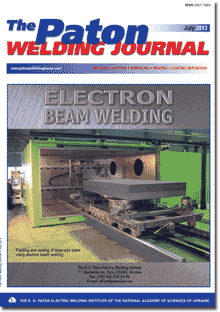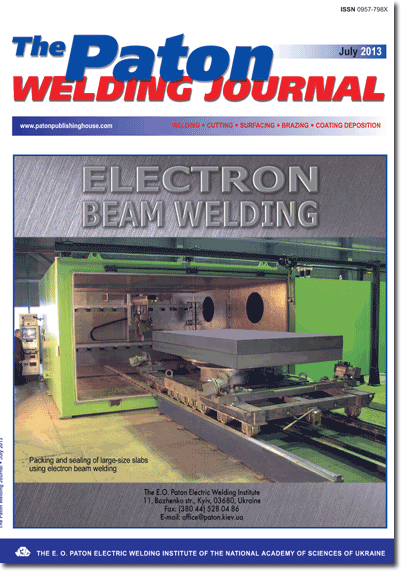| 2013 №07 (09) | 2013 №07 (01) |

The Paton Welding Journal, 2013, #7, 61-65 pages
CALCULATION OF MODE PARAMETERS OF WALL BEAD DEPOSITION IN DOWNHAND MULTI-PASS GAS-SHIELDED WELDING
M.A. SHOLOKHOV and D.S. BUZORINA
«Shtorm» Ltd. 28 Bazhov Str., Verkhnyaya Pyshma, RF. E-mail: ekb@shtorm-its.ru
Abstract
Application of narrowed grooves is an effective method to increase welding process efficiency at simultaneous reduction of financial and energy expenses. One of the main difficulties in implementation of multi-pass welding technology 10 mm thick rolled metal structures using automated and robotized units is a high possibility of defect formation such as lack of penetration, in particular, in layer of the first pass (wall bead). Control of welding parameters determining heat input is one of the methods of penetration regulation. Dependencies between welding parameters in problem areas of the grooves and penetration depth were determined experimentally. On their basis the equations for determination of parameters of bead deposition at given coefficient of areas were obtained. These results became a part of algorithm development to control welding mode parameters in automated and robotized units. 12 Ref., 1 Table, 6 Figures.
Keywords: mechanized consumable electrode welding, total heat efficiency of welding process, full-factor experiment, coefficient of areas, mathematic modelling, determination of parameters of welding mode
Received: 03.06.13
Published: 28.07.13
References
1. Rakhmatullin, T.A., Sholokhov, M.A., Buzorina, D.S. (2012) Problems of implementation of narrowed gaps in welding of hull structures of special engineering. Izvestiya Vuzov. Mashinostroenie, 4, 64-66.
2. Berezovsky, B.M. (2003) Mathematical models of arc welding. Vol. 2: Mathematical modeling and optimization of formation of different type welds. Chelyabinsk: YuUrGU.
3. Goncharov, N.S. (2009) Investigations and development of technology of twin-arc shielded-gas automatic welding of hulls from high strength medium alloy steels: Syn. of Thesis for Cand. of Techn. Sci. Degree. Ekaterinburg.
4. Lebedev, V.A. (2011) Control of penetration in mechanized welding and surfacing. Svarochn. Proizvodstvo, 1, 3-11.
5. Erokhin, A.A. (1973) Basics of fusion welding. Physical-chemical principles. Moscow: Mashinostroenie.
6. Chernyshov, G.G., Pankov, V.V., Markushevich, I.S. (1984) Influence of mode parameters on formation of wall bead in welding with deep grooves. Svarochn. Proizvodstvo, 12, 14-16.
7. Berezovsky, B.M. (2002) Mathematical models of arc welding. Vol. 1: Mathematical modeling and information technologies, models of weld pools and weld formation. Chelyabinsk: YuUrGU.
8. Sas, A.V., Gladkov, E.A. (1983) Technological process of welding as a object in ACS. Izvestiya Vuzov. Mashinostroenie, 8, 144-146.
9. (2007) Theory of welding processes: Manual. Ed. by V.M. Nerovny. Moscow: N.E. Bauman MGTU.
10. Razmyshlyaev, A.D. (1982) Hydrodynamic parameters of liquid metal film on the front wall of pool crater in arc welding. Avtomatich. Svarka, 1, 20-25.
11. Potapievsky, A.G. (1974) Consumable-electrode shielded-gas welding. Moscow: Mashinostroenie.
12. Sholokhov, M.A., Oskin, I.E., Erofeev, V.A. et al. (2012) Distribution of arc heat power in consumable-electrode narrow-gap welding. Svarka i Diagnostika, 4, 18-23.
Suggested Citation
M.A. SHOLOKHOV and D.S. BUZORINA (2013) CALCULATION OF MODE PARAMETERS OF WALL BEAD DEPOSITION IN DOWNHAND MULTI-PASS GAS-SHIELDED WELDING. The Paton Welding J., 07, 61-65.The cost of subscription/purchase order journals or individual articles
| Journal/Currency | Annual Set | 1 issue printed |
1 issue |
one article |
| TPWJ/USD | 384 $ | 32 $ | 26 $ | 13 $ |
| TPWJ/EUR | 348 € | 29 € | 24 € | 12 € |
| TPWJ/UAH | 7200 UAH | 600 UAH | 600 UAH | 280 UAH |
| AS/UAH | 1800 UAH | 300 UAH | 300 UAH | 150 UAH |
| AS/USD | 192 $ | 32 $ | 26 $ | 13 $ |
| AS/EUR | 180 € | 30 € | 25 € | 12 € |
| SEM/UAH | 1200 UAH | 300 UAH | 300 UAH | 150 UAH |
| SEM/USD | 128 $ | 32 $ | 26 $ | 13 $ |
| SEM/EUR | 120 € | 30 € | 25 € | 12 € |
| TDNK/UAH | 1200 UAH | 300 UAH | 300 UAH | 150 UAH |
| TDNK/USD | 128 $ | 32 $ | 26 $ | 13 $ |
| TDNK/EUR | 120 € | 30 € | 25 € | 15 € |
AS = «Automatic Welding» - 6 issues per year;
TPWJ = «PATON WELDING JOURNAL» - 12 issues per year;
SEM = «Electrometallurgy Today» - 4 issues per year;
TDNK = «Technical Diagnostics and Non-Destructive Testing» - 4 issues per year.


